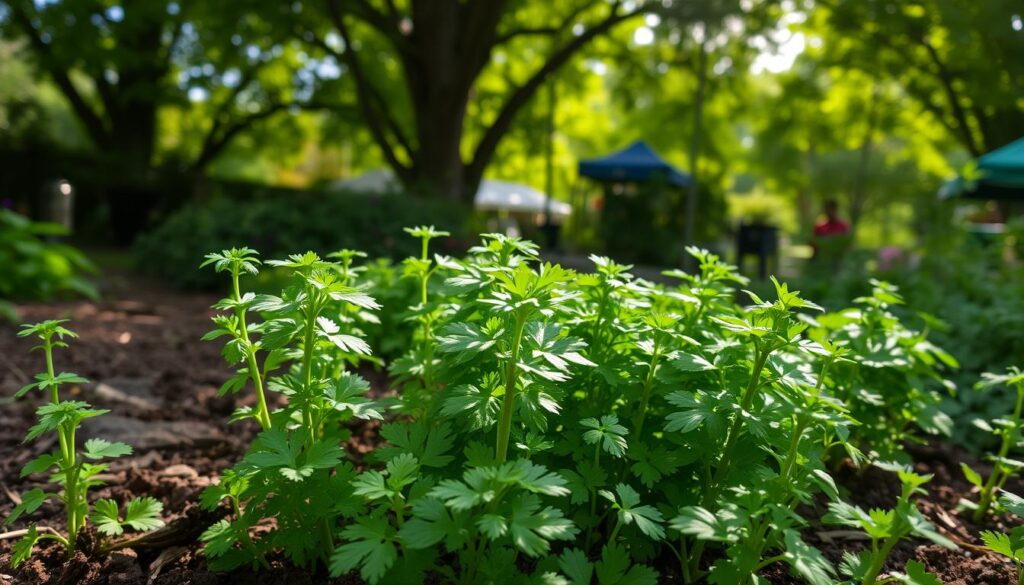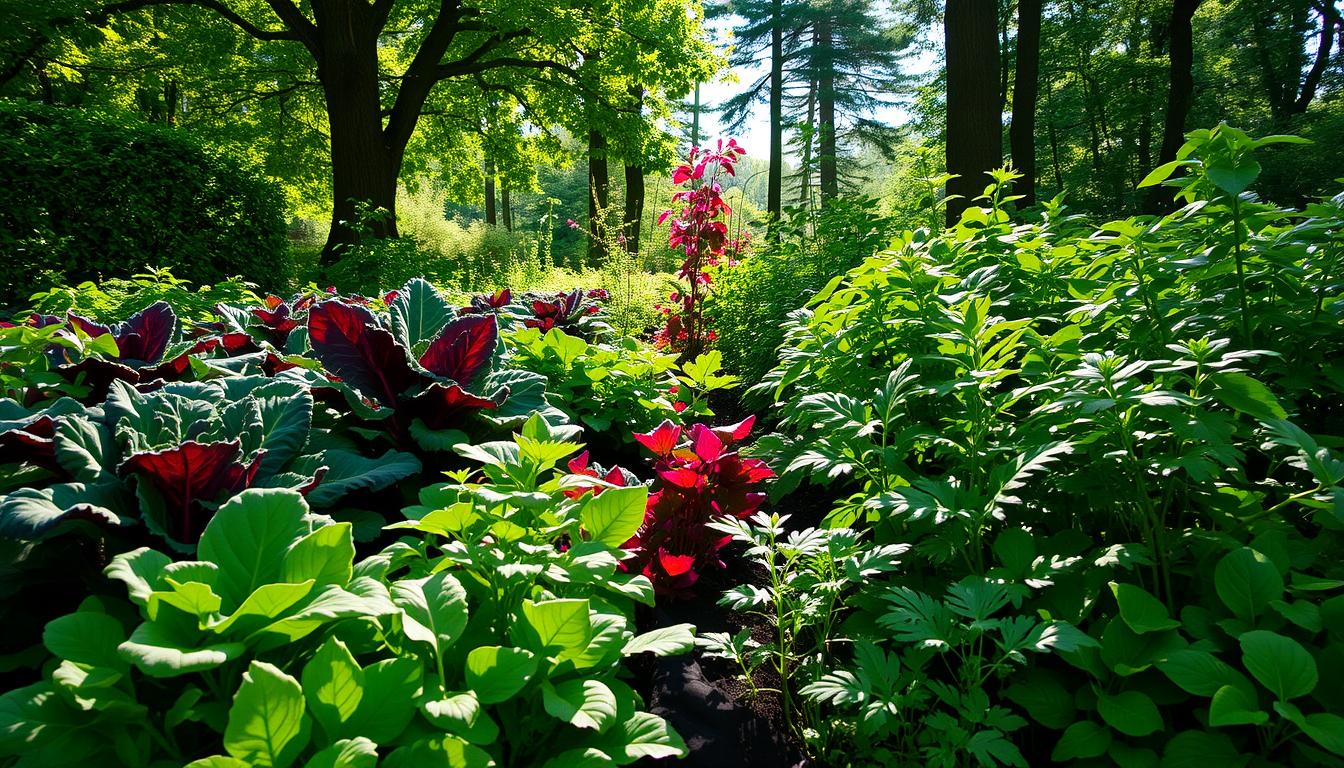I love gardening, but it can be tough in shady spots. Yet, with the right plants and tips, you can make a shady garden flourish. This guide will show you the top veggies for shady areas and how to make your garden a success.
Key Takeaways
- Discover the best vegetable varieties that thrive in shady garden conditions
- Learn how to assess your garden’s light levels and understand partial shade requirements
- Explore leafy greens, root crops, and cool-season favorites that excel in low-light areas
- Discover shade-tolerant herbs to add flavor and aroma to your shady garden
- Understand the importance of soil preparation and cultivation techniques for shady gardens
Embracing the Challenge of Shady Gardening
Gardening in shady spots can be tough, but it’s doable. Knowing the partial shade conditions and light levels in your garden is key. This knowledge helps you succeed with shady gardening.
Understanding Partial Shade Conditions
Partial shade means your garden gets sun and shade at different times. This depends on your garden’s direction, nearby trees, and the season. You might see:
- Morning sun, afternoon shade
- Dappled shade from overhead trees
- Shaded spots near buildings or fences
Assessing Your Garden’s Light Levels
First, you need to measure garden light to pick the right veggies. Use a light meter or watch how sun and shade change. Remember, light patterns shift with the seasons.
Knowing the challenges of shady gardening and checking your garden’s light helps. You can then enjoy a great harvest, even in shady spots.
The Best Vegetables for Shady Gardens
Gardening in shady areas can be a unique challenge. But, there are many vegetables that do well in low light. By knowing which best vegetables for shade, shade-tolerant vegetables, and vegetables that grow in low light are, you can make your shady garden full and vibrant.
Leafy greens like spinach and lettuce are great for shady spots. They are packed with nutrients and do well in partial shade. Broccoli and peas also love the shade and give a lot of harvest with little sun.
Herbs like cilantro add flavor and aroma to your shady garden. They grow well in low light, making them perfect for cooking.
When planning your shady garden, think about soil, water, and pests. Paying attention to these helps your best vegetables for shade grow well. This way, you can get a lot of harvest, even in tough growing conditions.
Leafy Greens: Nature’s Shade-Lovers
Leafy greens are top picks for shady gardens. Spinach and lettuce stand out, packed with nutrients and easy to grow in the shade.
Spinach: A Nutrient-Rich Powerhouse
Spinach is a strong and adaptable leafy green that loves the shade. It’s full of vitamins, minerals, and antioxidants. This makes it a great choice for those who care about their health.
Spinach does well in partial shade. This means you can still get a big harvest even in spots with little sunlight.
Lettuce: Versatile and Easy to Grow
Lettuce is another great choice for shady spots. It comes in many types, from crisp romaine to soft butterhead. Lettuce grows well in the shade and needs little care.
It’s easy to keep getting fresh leaves from your lettuce. This makes it perfect for shady gardens.
By choosing shade-loving leafy greens, gardeners can enjoy tasty and healthy food. Spinach and lettuce are great for shady gardens. They add flavor and nutrition to any meal.
Root Crops: Underground Treasures
Many root vegetables love full sun, but some can grow well in partial shade. As a gardener, I’ve found joy in growing underground crops in shady spots. I’m eager to share my knowledge with you.
The carrot is a great choice for shady gardens. These orange gems can handle some shade, but they might take longer to grow. Opt for shorter varieties like ‘Nantes’ or ‘Chantenay’ for the best results.
- Carrots are packed with vitamin A, which is good for your eyes and skin.
- They’re perfect for small gardens because they can grow in raised beds or containers.
Radish is another root crop that does well in shade. These peppery veggies grow fast and can even handle full shade. They might be smaller, though.
| Vegetable | Sun Requirement | Shade Tolerance |
|---|---|---|
| Carrots | Full sun | Partial shade |
| Radishes | Full sun | Full shade |
To grow root vegetables for shade, pick varieties that like lower light. With some trial and error, you can harvest plenty of underground vegetables for shady gardens.
Cool-Season Favorites for Shady Spots
Gardening in the shade can be tricky, but some cool-season veggies do great in the shade. Broccoli and peas are top picks for shady gardens. They’re not only tasty but also add beauty to your garden.
Broccoli: A Nutritional Superstar
Broccoli loves the shade and is packed with nutrients. It’s full of vitamins, minerals, and antioxidants. This makes it a great choice for a cool-season vegetables for shade garden.
It might take longer to grow in the shade, but it’s worth it. The wait is rewarded with delicious broccoli.
Peas: Sweet and Satisfying
Peas are another great pick for growing vegetables in the shade. They love cooler weather and can handle some shade. Peas are perfect for small gardens or containers because they grow up and don’t need much space.
They taste amazing and are very nutritious. If you love broccoli and peas, you’ll want to grow them.
When planning your shady garden, think about these cool-season favorites. With a bit of care, you can have a big harvest of broccoli and peas in shady spots.
Shade-Tolerant Herbs for Flavor and Aroma
Herbs can add flavor and beauty to any shady garden. Cilantro is a great choice for shady spots. It makes many dishes taste better.
Cilantro: A Versatile Herb for Any Dish
Cilantro, also known as coriander, grows well in low light. Its bright green leaves and unique smell are perfect for shady gardens. It’s great for adding flavor to many dishes, like salsas, curries, pesto, and salads.
Growing cilantro in a shade-loving herbs garden is easy. It doesn’t need direct sunlight. This makes it a great choice for your shady vegetables. It’s fast-growing and easy to care for, perfect for cooks and gardeners.
“Cilantro is the unsung hero of the herb world, bringing its bright, citrusy notes to countless dishes and elevating the flavors of even the simplest recipes.”
Cilantro is perfect for adding a fresh taste to salsas, curries, and pesto. It’s a versatile and shade-tolerant herb that’s great for your shady garden.

Maximizing Your Shady Garden Space
When you grow veggies in shady spots, using your space wisely is key. Try vertical gardening and companion planting to get the most out of your garden. This will boost your harvest and make gardening more efficient.
Vertical Gardening Techniques
Vertical gardening is a smart choice for shady gardens. It lets you grow many shady garden layout veggies without taking up too much ground. Here are some great ideas:
- Trellises for climbing veggies like peas, beans, and cucumbers
- Hanging baskets for plants like strawberries and cherry tomatoes
- Shelving units or tiered planters for leafy greens and herbs
Companion Planting for Shade Gardens
Companion planting is a natural way to enhance your maximizing space in shade garden. Pairing plants wisely can boost yields and create a healthier garden. For shady spots, try these companion planting pairs:
- Lettuce and radishes: Radishes grow fast, loosen the soil, and shade the slower-growing lettuce
- Spinach and carrots: Spinach’s broad leaves keep moisture in for carrots’ deep roots
- Broccoli and marigolds: Marigolds’ strong scent keeps pests away from broccoli
By using vertical gardening and companion planting, you can make your shady garden layout more productive. Enjoy a rich harvest, even in tough light conditions.
Soil Preparation for Shady Garden Success
Starting a shady garden means focusing on the soil first. Growing veggies in the shade needs the right soil. Let’s look at what’s important for your shady garden’s soil.
Adding soil for shady gardens is key. Use compost or manure to boost nutrients and help with water. This feeds your plants and makes the soil better for water and air.
Checking and changing the soil pH is also vital. Most veggies like a slightly acidic soil, between 6.0 and 6.8 pH. If your soil is too alkaline, add sulfur or peat moss. For too acidic soil, use lime to raise the pH.
- Incorporate organic matter to enrich the soil and improve drainage
- Test and adjust the soil pH to the optimal range for shady garden vegetables
- Ensure the soil is well-aerated to support healthy root growth
By preparing the soil for shady gardens, you set up your veggies for success. With the right soil preparation, your shady garden will flourish.
“The key to a successful shady garden lies in the soil – it’s the foundation that supports your plants’ growth and health.”
Watering and Pest Management in Shady Gardens
Keeping the right moisture and controlling pests are key for a shady garden’s success. Using the right watering methods and pest control can help your shady garden grow well.
Watering Shady Gardens
Shady gardens need less water than sunny ones because they lose less moisture. It’s important to check the soil moisture and give your plants the right amount of water. The soil should be moist but not too wet, which can cause root rot.
Using drip irrigation or soaker hoses can help water your plants efficiently. Also, adding mulch around your plants keeps the soil moist and stops weeds.
Identifying and Controlling Shade Garden Pests
Shade-loving veggies can face pests like slugs, snails, aphids, and fungal diseases. Look for signs of pests, such as chewed leaves or powdery mildew.
- Slugs and snails can be controlled with organic barriers or by picking them off.
- Aphids can be managed with beneficial insects or insecticidal soap.
- Fungal diseases can be prevented by improving air circulation and using organic fungicides.
By being watchful and using these pest control for shade methods, you can keep your shade garden pests under control. This way, you’ll have a great harvest from your watering shady gardens.
| Pest | Symptoms | Control Methods |
|---|---|---|
| Slugs and Snails | Chewed leaves, slimy trails | Copper tape, diatomaceous earth, hand-picking |
| Aphids | Curled, discolored leaves | Beneficial insects, insecticidal soap |
| Powdery Mildew | White, powdery fungal growth | Improve air circulation, organic fungicides |
By using these managing shady gardens tips, your shady garden will flourish. It will give you a rich harvest.

Harvesting and Enjoying Your Shady Garden Bounty
As your shady garden grows, you can’t wait to pick your own food. Knowing when to harvest is key to getting the best taste and nutrition. A few simple tips can make harvesting both easy and rewarding.
Harvest most vegetables in the morning when they’re full of water and the air is cool. This keeps them fresh and prevents them from wilting. For leafy greens like spinach and lettuce, pick the outer leaves. This lets the inner leaves keep growing.
Root vegetables like carrots and beets are ready when their tops start to show. Carefully dig around the roots, then pull them up gently. Don’t hurt the tender tubers. For herbs like cilantro, cut the leaves or stems just above the soil. This helps the plant grow back.
Now, it’s time to enjoy your fresh harvest. Leafy greens are great in salads. Root vegetables can be roasted, steamed, or stir-fried. Herbs like cilantro add flavor to many dishes, from salsas to curries.
Shady gardening offers unique challenges and rewards. You can grow delicious, healthy vegetables. These are perfect for feeding your body and pleasing your taste buds.
Conclusion
As we finish our look at the best veggies for shady gardens, I’m sure you’re ready to start your own. You now have the knowledge to make a shady garden that’s both productive and beautiful. This guide has given you the tools to succeed.
We’ve talked about leafy greens that love partial shade and root crops that do well in deep shadows. This guide has shown you many options for growing veggies in the shade. We’ve also covered important tips for successful shady gardens, like how to prepare the soil and manage pests.
By taking on the challenge of shady gardening, you’ll create a garden that’s both fruitful and visually stunning. Remember, choose the right veggies for shade, make the most of your garden’s light, and use the best techniques for summary of shady gardening. With these tips, your shady garden will thrive for years.



Leave a Reply